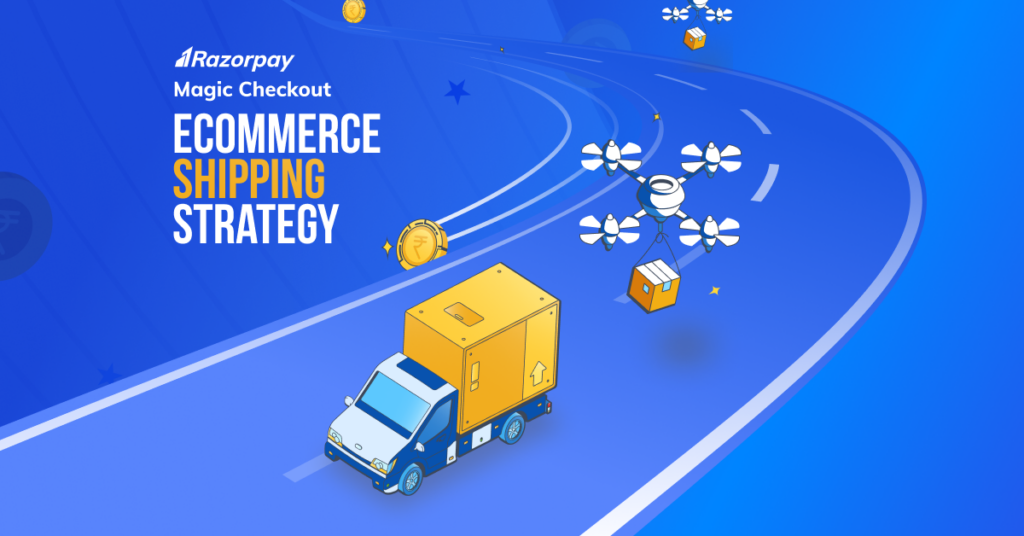eCommerce shipping solution in India- the strategy, how to calculate the shipping cost, and more. Everything is ready for you in this Razorpay Magic Checkout, a one-click checkout solution blog post.
A lot of effort goes into providing the best shopping experience to customers. From selecting the right products, ensuring the online store is easy to navigate, choosing a reliable shipping partner, and providing a seamless checkout process, the goal of any eCommerce business is to leave customers satisfied and make them repeat buyers.
Choosing a reliable shipping partner is an integral part of running a successful business. Here’s an interesting stat- 36% of online shoppers abandon their carts when they realize they have to pay for shipping.
While a lot of customers ask for free shipping, providing free shipping isn’t as simple as it looks. Someone has to pay for that shipping.
Big E-retailers can absorb the shipping costs, but the same isn’t true for every eCommerce/D2C business. The goal here is to prepare an eCommerce shipping strategy that will keep customers happy without eroding business profits. Simply put, you need a shipping strategy that is designed for the sustainable growth of your eCommerce business.
Related Read: What is the Trademark Logo Registration Process in India?
The Basics

You would do well to set up a concrete foundation for an optimal eCommerce shipping strategy based on the following parameters:
Weight and Size: The weight of the product will play a significant factor in determining the overall shipping cost. In some cases, the cost of a heavier parcel with a smaller size could be the same as a lighter parcel but with a larger size. Speaking to the shipping partner thus becomes necessary to understand how they charge you based on weight and size.
Packing Materials: Fragile, sensitive, and perishable products will require extra packaging materials to keep the product inside intact. Your shipping partner will be able to tell you about the exact price in case any extra packaging is required.
Unpacking Delight: Think about how you can delight your customers when they open the shipment box. Think of handwritten notes, colorful confetti, seasonal freebies, etc.
Delivery Method: Do you want the package to be picked up from your facility, or would you deliver the package to the shipping company? Would you pack the products on your own, or do you want your shipping partner to take care of that? Are you thinking about dropshipping, managed inventor, and fulfilment? All these things have to be thought of beforehand. There are shipping companies who can pack your products on your behalf. Speak to them and find out the charges for the same and then decide.
Read Also: 14 Must-Have WooCommerce Plugins For Your E-commerce Store
Determining Shipping Rates
Free Shipping
93% of customers shop more when they see free shipping. Offering free shipping to customers can reduce your cart abandonment rates, but as we said earlier, shipping is never free. Someone will have to pay for it. Here are a few options that you can try:
- When showing the product price, you can increase the product price to make up for the shipping cost.
- You can provide free shipping on best-selling products and bear the cost on your own.
- Instead of increasing the price of the product completely, you can increase it slightly to cover the partial shipping cost.
- Offer coupon codes to your customers to make up for the shipping cost.
- You can provide free shipping on a minimum order value.
Real-Time Rates
Real-time or live rates allow eCommerce/D2C businesses to offer shipping rates in real-time. Whatever shipping rates are asked by the shipping company with regard to the weight and size of the product and the distance covered, the same price will be shown to customers. Everything gets synced in real-time, meaning if the shipping company increases the rate by 5%, it will be automatically updated on your online store. The customers will know the exact amount they need to pay, which can boost customer trust.
The recommended thing to do here is to add multiple shipping companies that offer real-time shipping rates and let customers choose and pay.
Flat Rates
Flat rates are quite popular and the easiest to set up. You apply a flat rate or a flat shipping charge on all your products regardless of how heavy or lightweight or how small or large they are. Flat rates shipping charges are ideal for eCommerce businesses with a standard product line. But if your store sells products of different sizes and weights, flat rates won’t be the right choice because then you have the risk of overcharging or undercharging your customers.
Table Rates
When flat rates don’t work for your eCommerce store, table rates can be a viable option. Table rates allow you to offer shipping rates based on sizes, weights, shipping classes, the total number of items, and destinations. Few rules that you can create using table rates:
- Ship products only when the order totaling is Rs.500 or more.
- Charge Rs. 100 when the weight is less than 5 kg, and for anything beyond 5 kg, charge Rs. 150.
- In case the delivery destination is within the same city as the online store, you can offer free shipping.
Below, you will see a few shipping calculators provided by some of the top shipping companies:
Choose Packaging Options Carefully

As eCommerce businesses grow, so do the expectations of customers. Earlier packaging used to be a way to pack products and send them to their destination safely. But packaging these days has become an effective medium to set oneself apart.
To create an exceptional brand image, one needs to think beyond factory bags.
Cardboard Boxes
Cardboard boxes remain the most trustworthy packaging material for businesses of all shapes and sizes. They are durable and sturdy. But to make it a marketing and branding tool, try some nifty personalization. For example, you can add hand-written notes to give it a personalized touch.
Paperboard or Mailers
Paperboards are suitable for products like jewelry, books, small electronic gadgets, and more. In the case of fragile items, you can secure the product even further by using bubble wrap. If you don’t want to use paperboard, you can go for plastic or poly mailers.
Paper Bags
Paper bags are quite popular in the eCommerce ecosystem because they are inexpensive and biodegradable. These highly customizable packaging materials can be used for small toys, inexpensive jewelry, and apparel.
Custom Packaging
While all the above-mentioned packaging materials are customizable, some eCommerce stores like to go out of the box to impress their customers. Custom packaging can provide customers with a unique unboxing experience. Although expensive, custom packaging can create a brand image for yourself. The custom box or custom paper bag (you can choose the type) can have brand logos, designs of your choice, and much more. You can let your imagination run wild with custom packaging.
Read Also: 8 Must-Have Shopify Apps to Grow Your eCommerce Business!
Communicating Shipping Prices

Communicating shipping prices to your customers is paramount. When you communicate with your customers properly, you present yourself as a trustworthy brand that believes in transparency. Also, being clear about the shipping cost will save you from miscommunication and after-sales troubles.
To communicate shipping prices effectively, try these tips:
No Surprises
Customers don’t like surprises when it comes to their money. Therefore, ensure to display the shipping charges clearly before they pay. The right thing to do here would be to display the shipping charges once they add the product and before they pay for their order. You can include a statement, such as “shipping charges may apply and will be calculated during checkout.”
Razorpay Magic Checkout, for example, calculates the shipping charges dynamically to let customers know the total cost they would be paying.
Read Also: VS Mani & Co.’s Order Conversion Rate Increased By 27% with Razorpay Magic Checkout
Answer Shipping-Related Queries on the FAQ Page
Every online store should have a dedicated FAQ page. When a customer is in doubt, they will try to get in touch with the business. But with a full-proof FAQ page in place, you will be able to take some pressure off the operations team.
On the FAQ page, ensure to explain the reason for the shipping cost. Tell them if the shipping price is calculated based on size, weight, or distance. Do you import your products or source materials from aboard? If yes, include that as a reason. Whatever the reason for the shipping price, provide customers with the correct reasoning.
Add a Shipping Video
If your customers have to pay for shipping, take this as an opportunity to boost engagement with customers. Create a video and explain everything. Just like the FAQ page, you can have a dedicated video just to explain the shipping cost and how it is calculated. This will make your business more transparent, and transparency is always appreciated by customers.
Tracking Shipping Status

Apart from showing customers the expected delivery date after they place an order, ensure to send timely shipment/package tracking details via email, SMS, WhatsApp, etc. When you share shipping status details proactively, you create positive branding. Include the following when you communicate with customers regarding their shipping statuses:
- Tell them the expected delivery date.
- Provide them with the shipping company’s name, tracking number, and a link to track the shipping status.
- In case of delays, let your customers know and tell them the reason for the delay.
On your website, don’t forget to add these details to every order. If you don’t have the feature to track shipping details on the website, never miss out on sending updates.
Wrapping Up
Free shipping may not be the best option for every eCommerce/D2C business. But implementing the correct eCommerce shipping strategy and reevaluating the strategy from time to time is crucial for business growth.
Related Read: What is eCommerce POS Integration & How to Streamline Offline & Online Sales?



